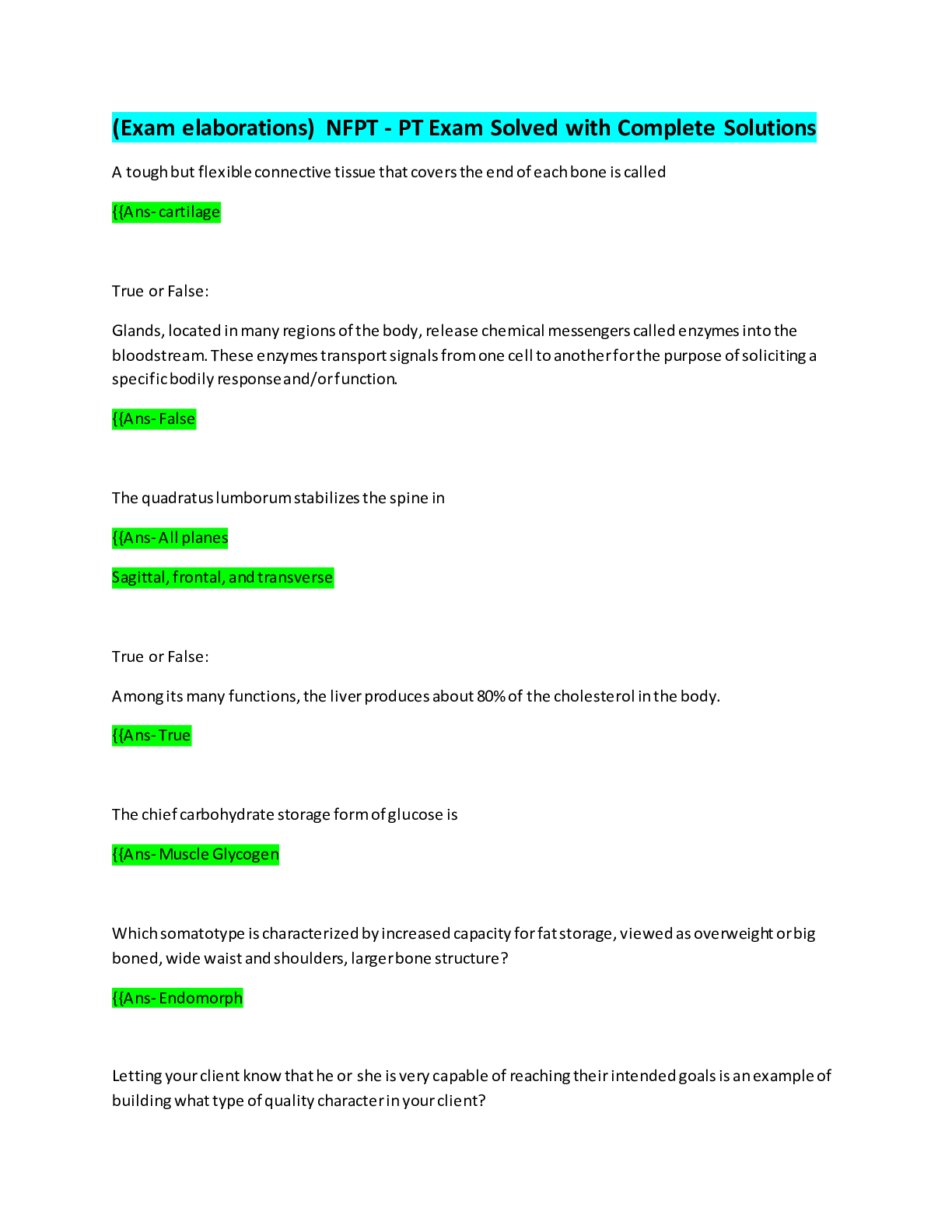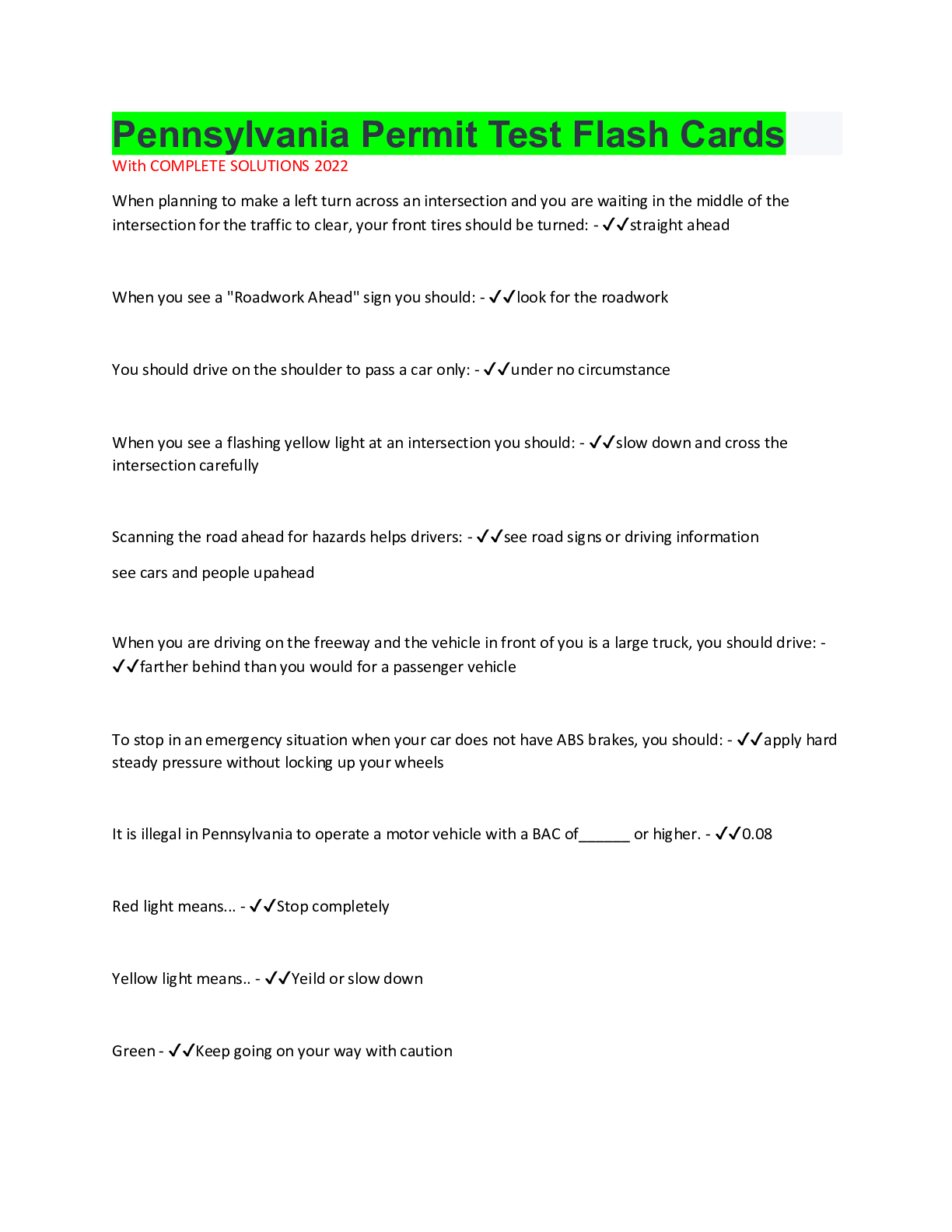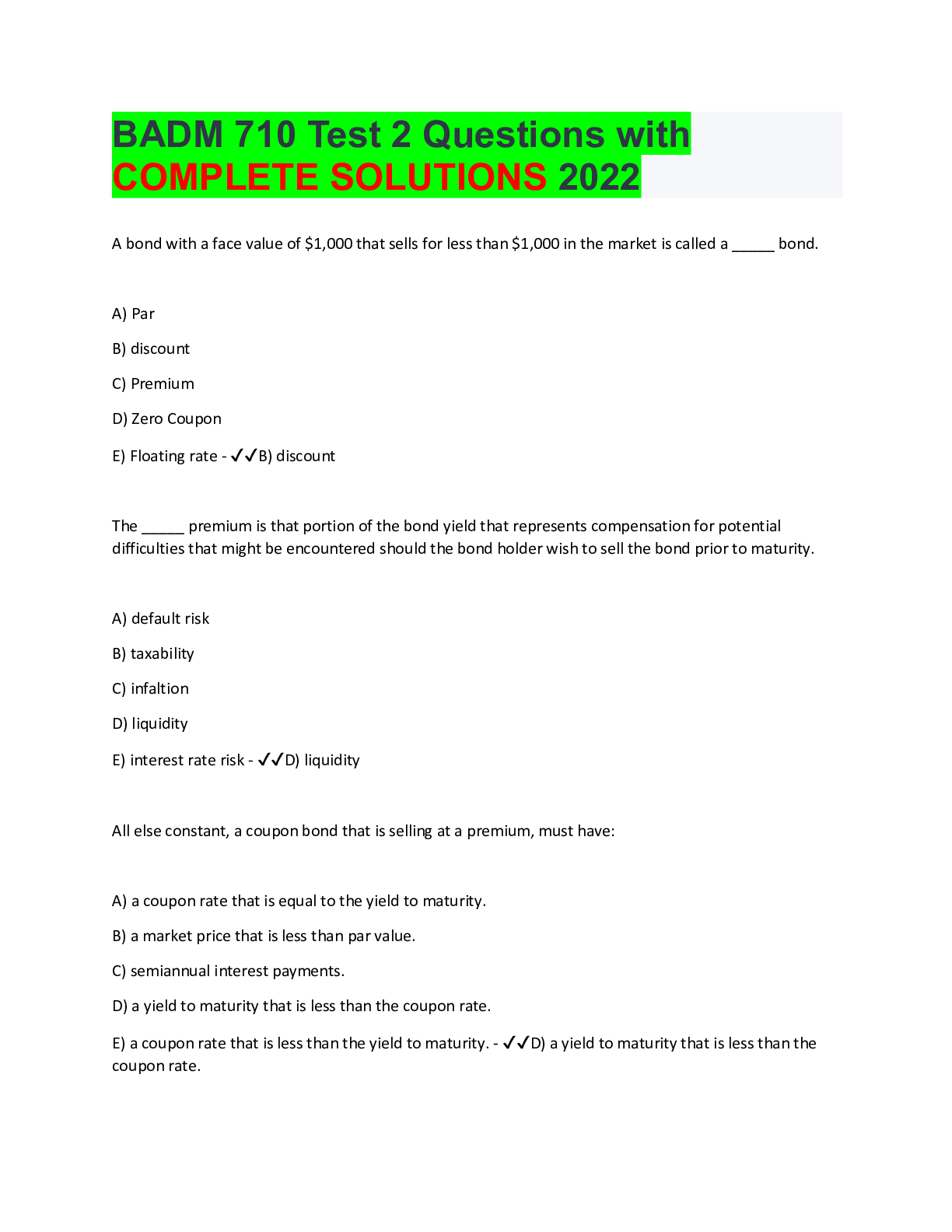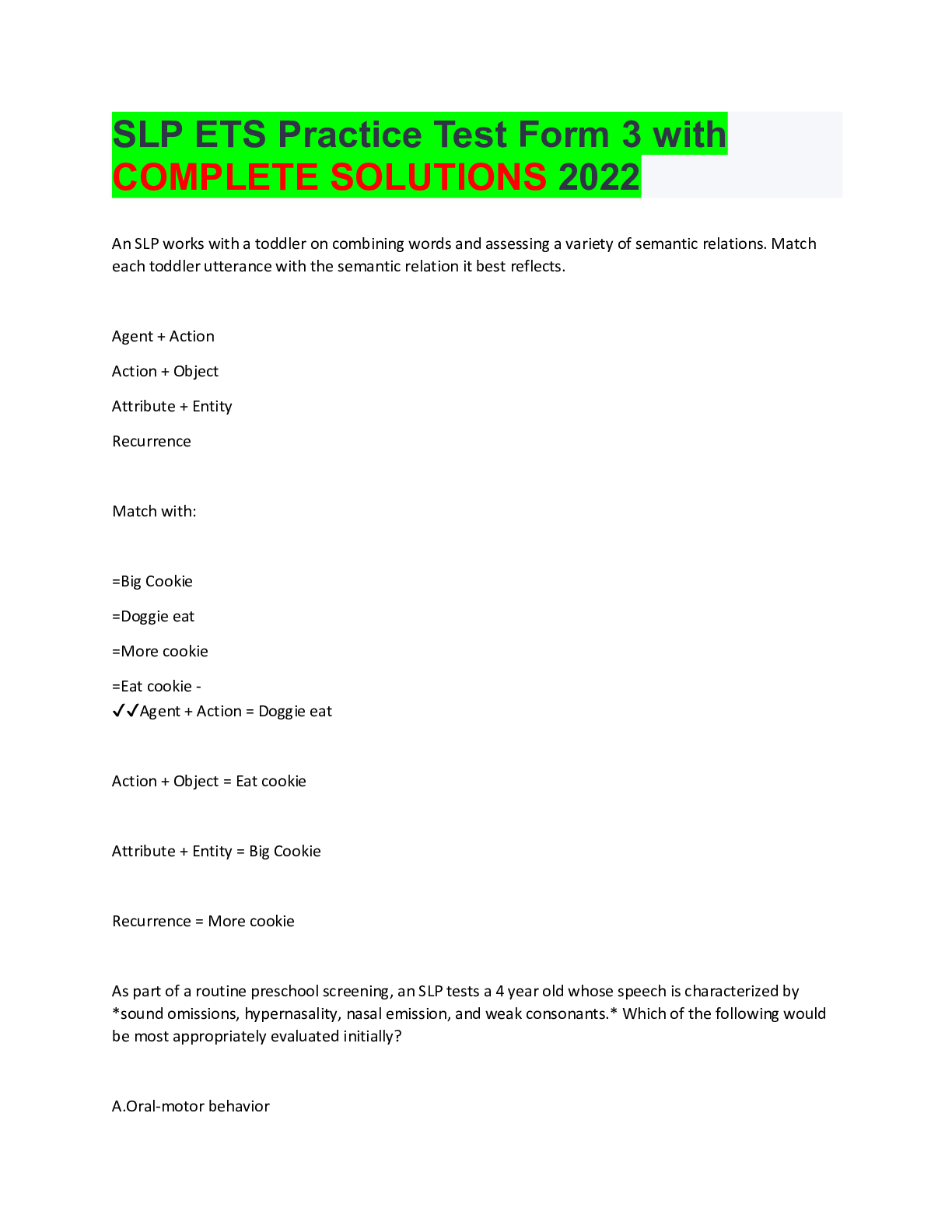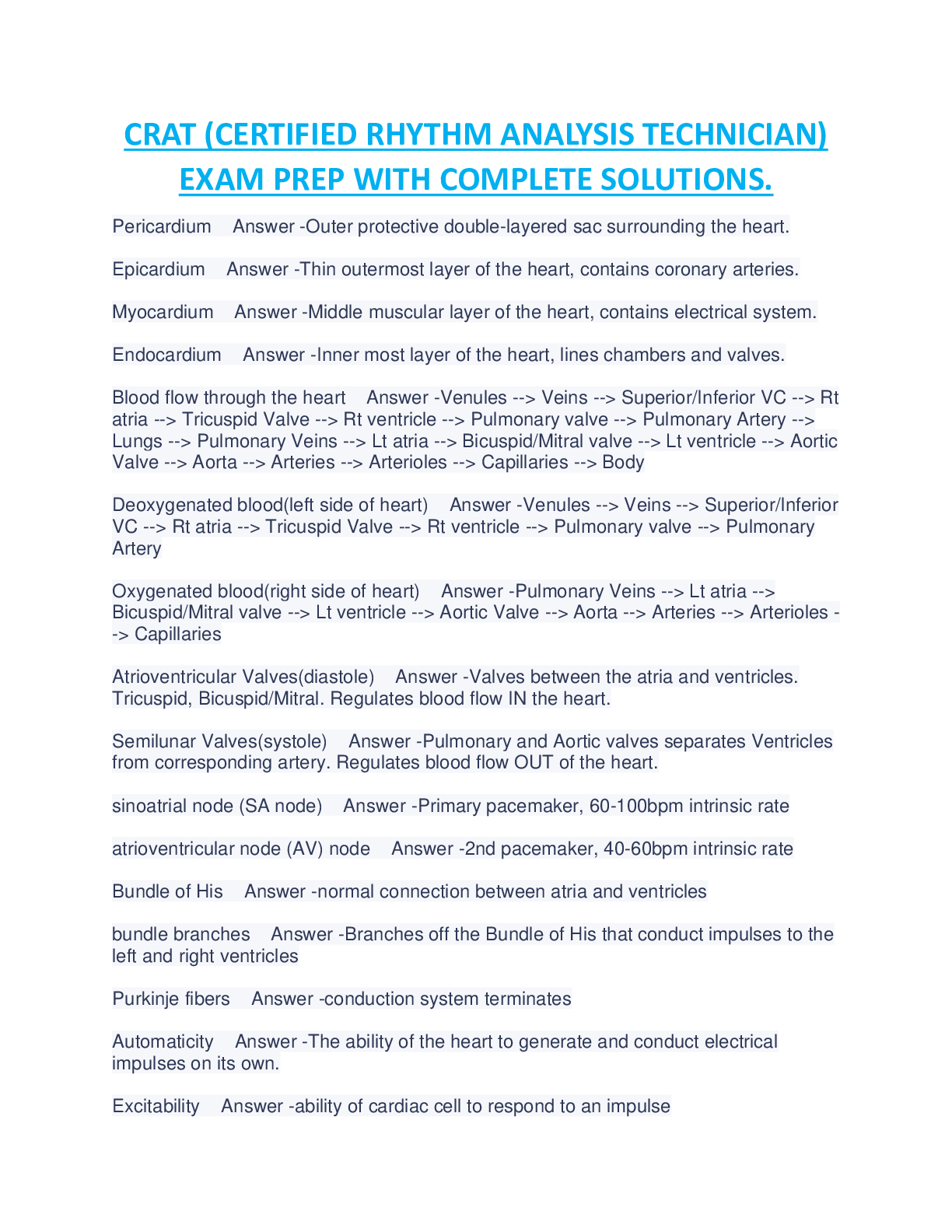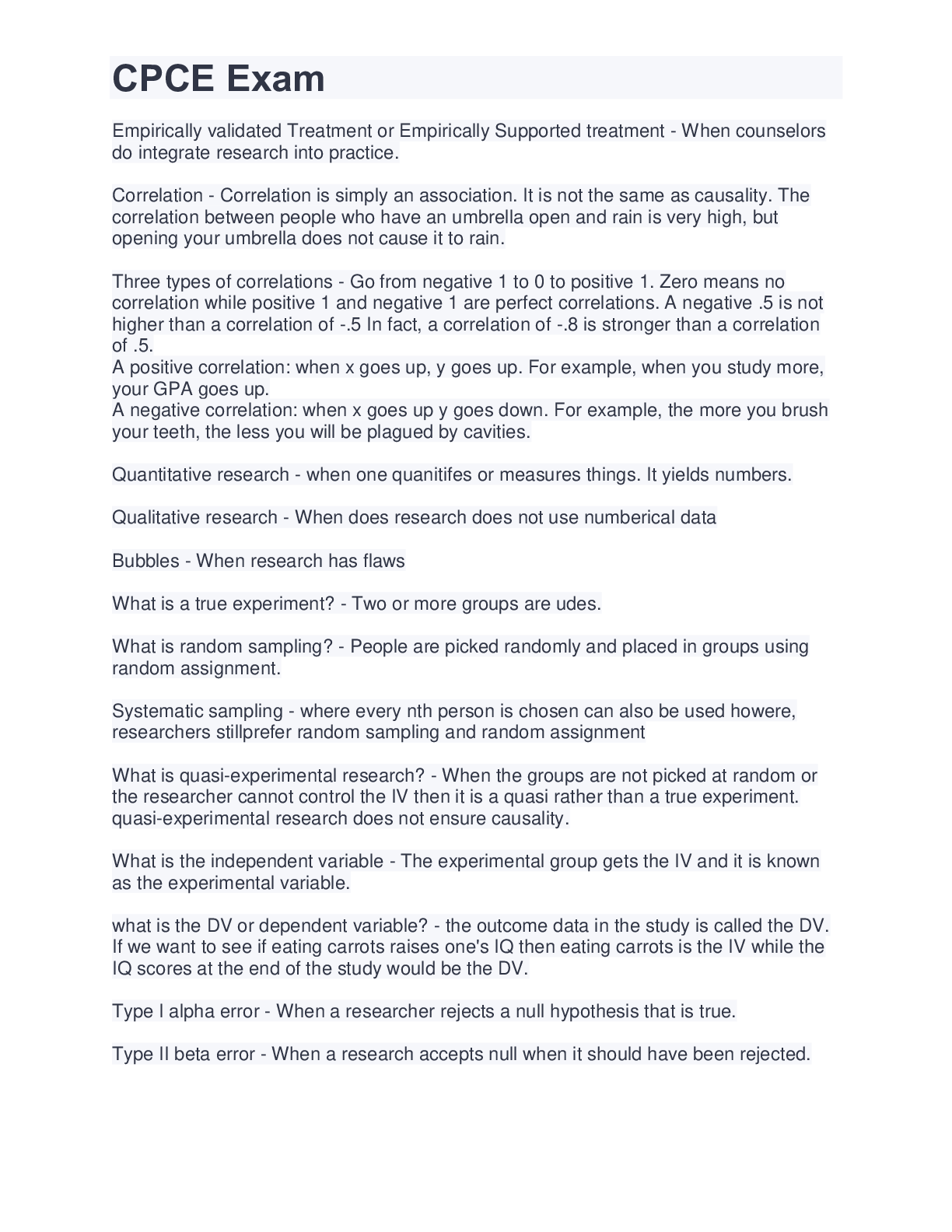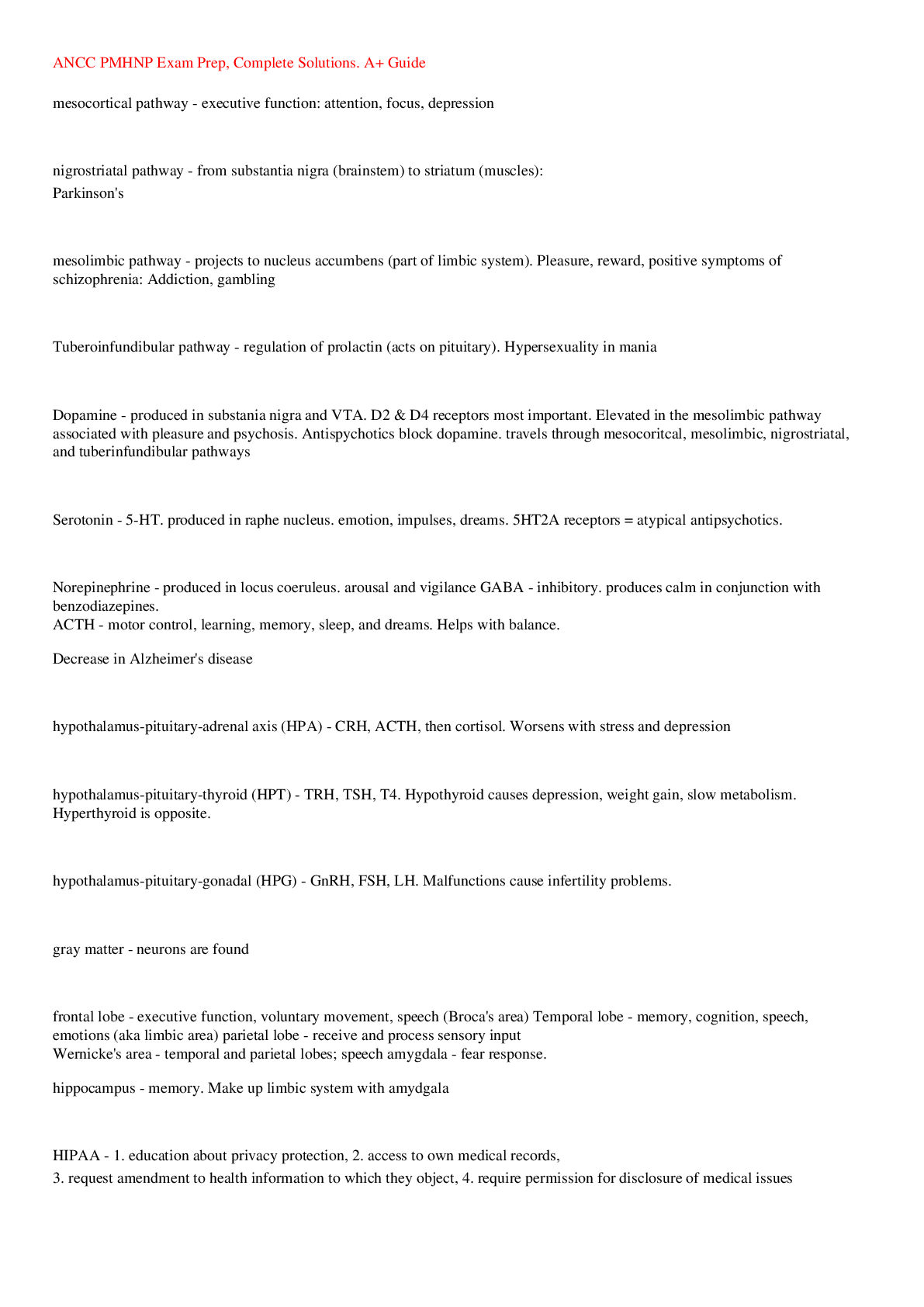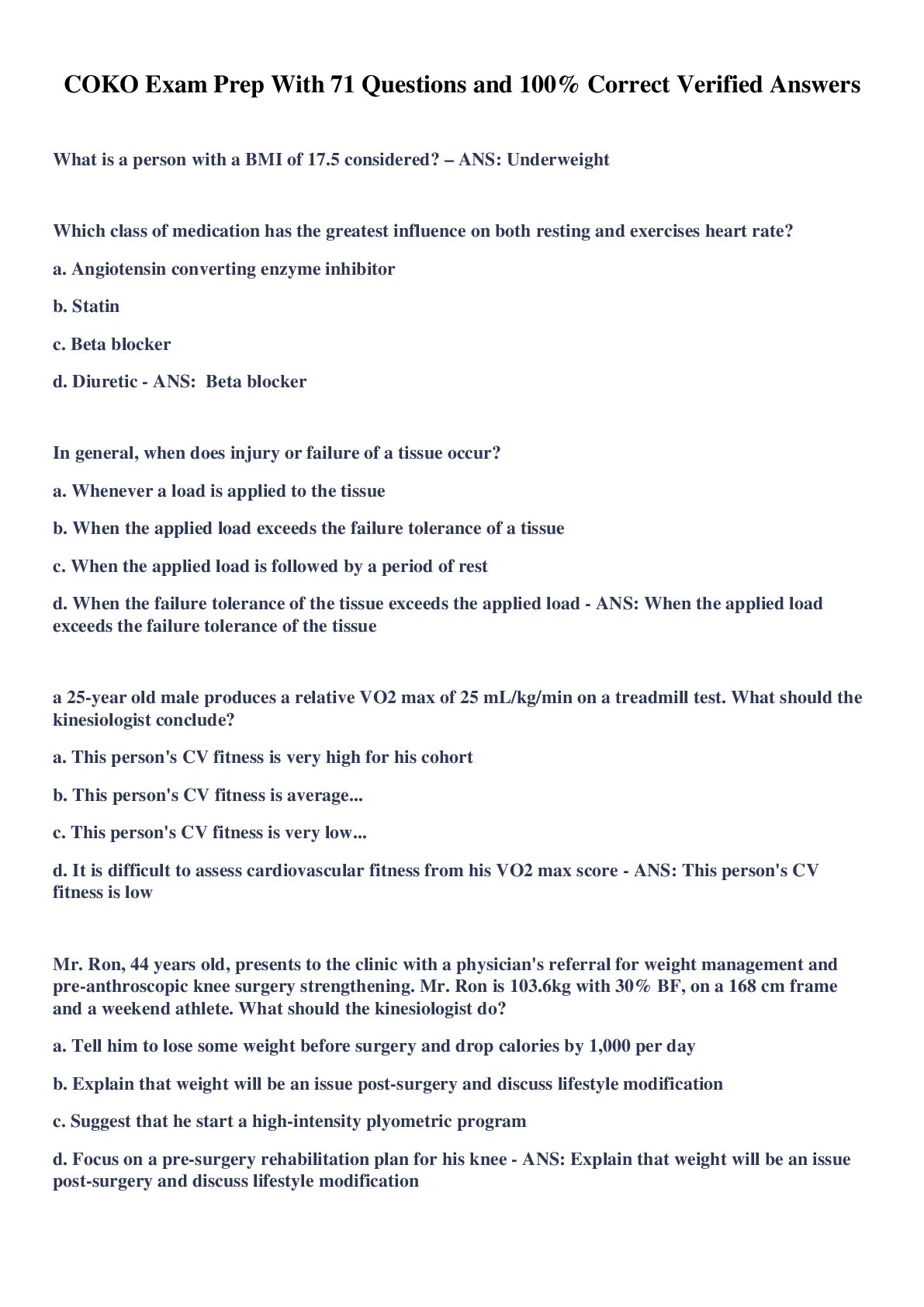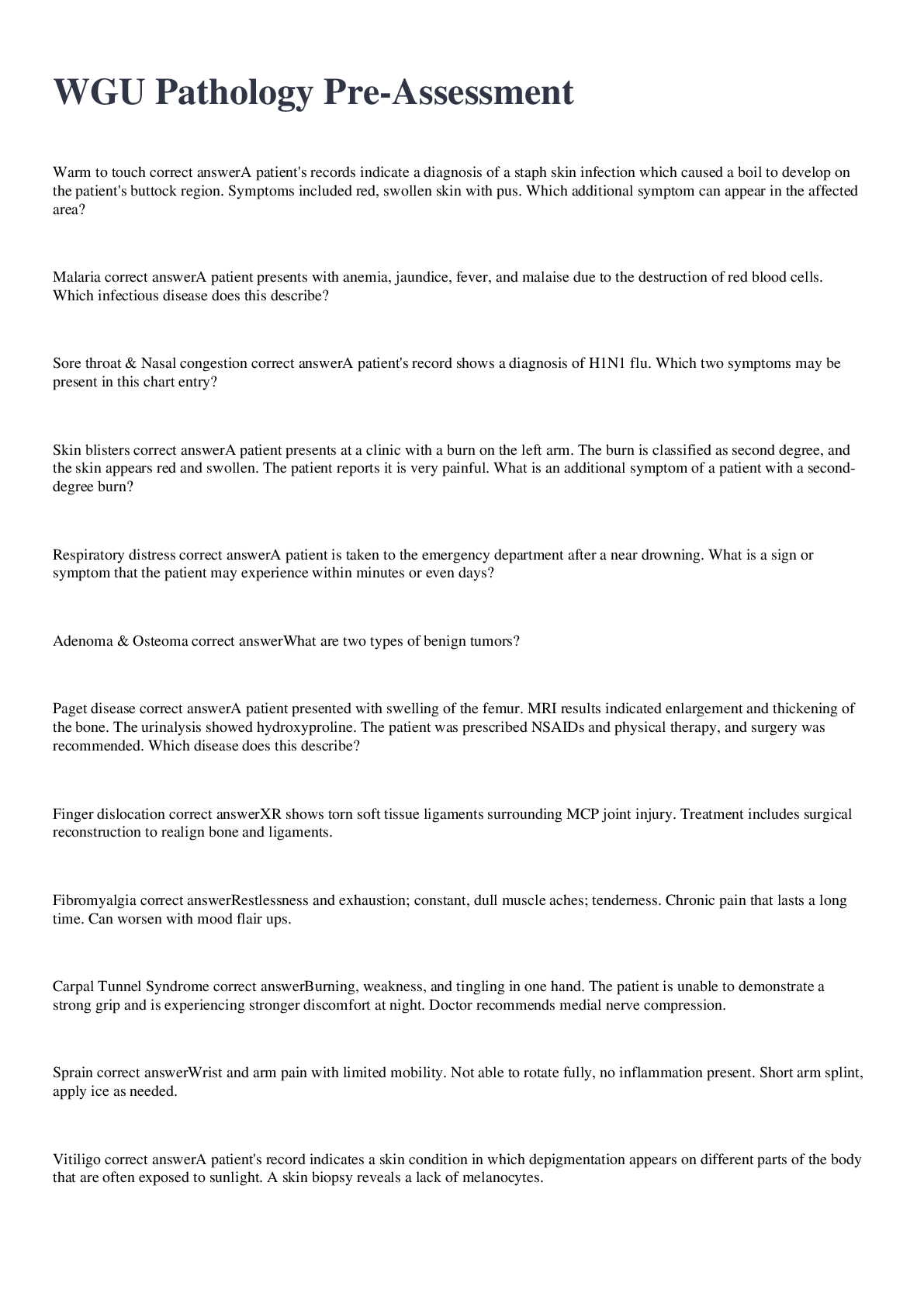NBCOT (COTA) Exam Prep with complete solutions 2022
Document Content and Description Below
Development of Sensorimotor Integration - ANSWER Prenatal Period Neonatal Period First 6mo 6-12mo 13-24mo 2-3yrs 3-7yrs Prenatal Period - ANSWER Responds first to tactile stimuli Reflex Deve... lopment Innate tactile, proprioceptive, and vestibular input reactions Neonatal Period - ANSWER Tactile, proprioceptive, and vestibular inputs are critical from birth onward for the eventual development of body scheme. Vestibular system, although fully developed at birth, continues to be refined and impacts on the infant's arousal. Helps the infant to feel more organized and content. Visual system develops as infant responds to human faces and items of high contrast places approximately 10in from the face. Auditory system is immature at birth and develops as the infant orients to voices and other sounds. First 6mo - ANSWER Vestibular, proprioceptive, and visual systems become more integrated and lay the foundation for postural control, which facilitates a steady visual field. Tactile and proprioceptive systems continue to be refined, laying the foundation for development of somatosensory skills. Visual and tactile systems become more integrated as the child reaches out and grasps objects, laying the foundation for eye-hand coordination. Infant movement patterns progress from reflexive to voluntary and goal directed. 6-12mo - ANSWER Vestibular, visual, and somatosensory responses increase in quantity and quality as the infant becomes more mobile. Tactile and proprioceptive perception becomes more refined, allowing for development of fine motor and motor planning skills. Tactile and proprioceptive responses also lead to midline skills and eventual crossing of midline. Auditory, tactle, and proprioceptive perception is heightened allowing for development of sounds for the purpose of communication. Tactile, proprioceptive, gustatory, and olfactory perception are integrated, allowing for primitive self-feeding. 13-24mo - ANSWER Tactile perception becomes more precise allowing for discrimination and localization to further refinement of fine motor skills. Further integration of all systems promotes the complexity of motor planning as the toddler's repertoire of movement patterns expands. Symbolic gesturing and vocalization promotes ideation, indicating the toddler's ability to conceptualize. Motor planning abilities contribute to self-concept as the toddler begins to master the environment. 2-3yrs - ANSWER This is a period of refinement as the vestibular, proprioceptive, and visual systems further develop, leading to improved balance and postural control. Further development of tactile discrimination and localization lead to improved fine motor skills. Motor planning and praxis ideation also progresses during this period for more skillful occupational performance. 3-7yrs - ANSWER Child is driven to challenge sensorimotor competencies through roughhouse play, playground activities, games, sports, music, dancing , arts and crafts, household chores, and school tasks. These occupations provide opportunities to promote psychosocial development and self-esteem. Crossing Midline - ANSWER As the child becomes more mobile, movement against gravity and weightshift increase, leading to eventual crossing of the midline, often in attempt to reach for a toy, while weightbearing on the opposing upper extremity for balance. Begins at 9-12mo. Laterality - ANSWER Hemispheric specialization for specific tasks varies with different individuals Bilateral Integration - ANSWER As the child experiments with movement, the nervous system is stimulated, and the resulting sensations help the child to coordinate the two sides of the body. Begins at 9-12mo. Visual-Motor Integration - ANSWER Dependent upon the lower level skills of visual attention, visual memory, visual discrimination, kinesthesia, position in space, figure ground, form constancy, and spatial relations. Oral-Motor Control - ANSWER Developed in the area of feeding, provides the foundation for early oral communication and later language development. Rooting Reflex - ANSWER Onset Age: 28wk gestation Integration Age: 3mo Stimulus: Stroke corner of the mouth, upper lip, and lower lip. Response: Movement of the tongue, mouth, and/or head toward stimulus. Relevance: Allows searching for and locating feeding source. Suck-Swallow Reflex - ANSWER Onset Age: 28wk gestation Integration Age: 2-5mo Stimulus: Place examiner's index finger inside infant's mouth with head in midline. Response: Strong, rhythmical sucking Relevance: Allows ingestion of nourishment Traction Reflex - ANSWER Onset Age: 28wk gestation Integration Age: 2-5mo Stimulus: Grasp infant's forearms and pull-to-sit Response: Complete flexion of upper extremeties Relevance: Enhances momentary reflexive grasp Moro Reflex - ANSWER Onset Age: 28wk gestation Integration: 4-6mo Stimulus: Rapidly drop infant's head backward Response: arm extension/ abduction, hand opening then arm flexion and adduction Relevance: Facilitates ability to depart from dominant flexor posture (protective response) Plantar Grasp Reflex - ANSWER Onset Age: 28wk Integration Age: 9mo Stimulus: Apply pressure with thumb on the infant's on the infant's ball of the foot. Response: Toe Flexion Relevance: Increases tactile input to the sole of the foot Galant Reflex - ANSWER Onset Age: 32wk gestation Integration Age: 2mo Stimulus: Hold infant in prone suspension, gently scratch or tap alongside side the spine with finger, from shoulders to buttocks. Response: Lateral trunk flexion and wrinkling of the skin on the stimulated side Relevance: Facilitates lateral trunk movements necessary for trunk stabilization. Asymmetric Tonic Neck Reflex (ATNR) - ANSWER Onset Age: 37wk gestation Integration Age: 4-6mo Stimulus: Fully rotate infant's head and hold for 5 sec Response: Extension of extremities on the face side, flexion of extremities on the skull side Relevance: Promotes visual hand regard Palmar Grasp Reflex - ANSWER Onset Age: 37wk gestation Integration Age: 4-6mo Stimulus: Place examiner's finger in infant's palm Response: Finger flexion (reflexive grasp) Relevance: Increases tactile input on the pal, of the hand. Tonic Labyrinthe (Supine) Reflex - ANSWER Onset Age: >37wk gestation Integration Age: 6mo Stimulus: Place infant in supine Response: Increased extensor tone Relevance: Facilitates total-body extensor tone Tonic Labyrinthe (Prone) Reflex - ANSWER Onset Age: >37wk gestation Integration Age: 6mo Stimulus: Place infant in prone Response: Increased flexor tone Relevance: Facilitates total-body flexor tone Labyrinthe (Optical Head Righting) Reflex - ANSWER Onset Age: Birth-2mo Integration Age: Persists Stimulus: Hold infant suspended vertically and tilt slowly (about 45°) to the side, forward, or backward Response: Upright positioning of the head Relevance: Orients head in space; maintains face vertical Landau Reflex - ANSWER Onset Age: 3-4mo Integration Age: 12-24mo Stimulus: Hold infant in horizontal prone suspension Response: Complete extension of head, trunk, and extremities Relevance: Breaks up flexor dominance; facilitates prone extension Symmetric Tonic Neck Reflex (STNR) - ANSWER Onset Age: 4-6mo Integration Age: 8-12mo Stimulus: Place infant in the crawling position and extend the head Response: Flexion of hips and knees Relevance: Breaks up total extensor posture; facilitates static quadruped position Neck Righting on Body (NOB) Reflex - ANSWER Onset Age: 4-6mo Integration Age: 5yrs Stimulus: Place infant in supine and fully turn head to one side Response: Log rolling of the entire body to maintain alignment with the head Relevance: Maintains head/body alignment; initiates rolling (first ambulation effort) Body Righting on Body (BOB) Reflex - ANSWER Onset Age: 4-6mo Integration Age: 5yrs Stimulus: Place infant in supine, flex one hip and knee toward the chest and hold briefly Response: Segmental rolling of the upper trunk to maintain alignment Relevance: Facilitates trunk/spinal rotation Downward Parachute (Protective extension downward) Reflex - ANSWER Onset Age: 4mo Integration Age: Persists Stimulus: Rapidly lower infant toward supporting surface while suspended vertically Response: Extension of the lower extremities Relevance: Allows accurate placement of lower extremities in anticipation of a surface Forward Parachute (Protective Extension Forward) Reflex - ANSWER Onset Age: 6-9mo Integration Age: Persists Stimulus: Suddenly tip infant foward toward supporting surface while vertically suspended Response: Sudden extention of the upper extremities, hand opening, and neck extension Relevance: Allows accurate placement of upper extremities in anticipation of supporting surface to prevent a fall. Sideward Parachute (Protective Extension Sideward) Reflex - ANSWER Onset Age: 7mo Integration Age: Persists Stimulus Quickly but firmly tip infant off-balance to the side while in sitting position Response: Arm extension to the side Relevance: Protects body to prevent a fall; supports body for unilateral use of opposite arm Backward Parachute (Protective Extension Backward) Reflex - ANSWER Onset Age: 9-10mo Integration Age: Persists Stimulus: Quickly but firmly tip infant off-balance backward Response: Backward arm extension or arm extension to one side spinal rotation Relevance: Protects body to prevent a fall; unilaterally facilitates Prone Tilting Reflex - ANSWER Onset Age: 5mo Integration Age: Persists Stimulus: After positioning infant in prone, slowly raise one side of the supporting surface Response: Curving of the spine toward the raised side (opposite to the pull of gravity); abduction/extension of arms and legs Relevance: Maintain equilibrium without arm support; facilitate postural adjustments in all positions Supine Tilting and Sitting Tilting Reflex - ANSWER Onset Age: 7-8mo Integration Age: Persists Stimulus: After positioning infant in supine or sitting, slowly raise one side of the supporting surface Response: Curving of the spine toward the raised side (opposite to the pull of gravity); abduction/extension of arms and legs Relevance: Maintain equilibrium without arm support; facilitate postural adjustments in all positions Quadruped Tilting Reflex - ANSWER Onset Age: 9-12mo Integration Age: Persists Stimulus: After positioning infant on all fours, slowly raise one side of the supporting surface Response: Curving of the spine toward the raised side (opposite to the pull of gravity); abduction/extension of arms and legs Relevance: Maintain equilibrium without arm support; facilitate postural adjustments in all positions Standing Tilting Reflex - ANSWER Onset Age: 12-21mo Integration Age: Persists Stimulus: After positioning infant in standing, slowly raise one side of the supporting surface Response: Curving of the spine toward the raised side (opposite to the pull of gravity); abduction/extension of arms and legs Relevance: Maintain equilibrium without arm support; facilitate postural adjustments in all positions Prone Position - ANSWER 0-2mo: Turns head side to side. lifts head momentarily. Bends hips with bottom in air. Lifts head and sustains midline. Rotates head freely when up. Able to bear weight on forearms. Able to tuck chin and gaze at hands in forearm prop. Attempts to weight shift on forearms, resulting in a shoulder collapse. 5-6mo: Shifts weight on forearms and reaches forward. Bears weight and shifts weight on extended arms. Legs are closer together and thighs roll inward toward natural alignment. Hips are flat on surface. Equilibrium reactions are present. 5-8mo: Airplane posturing in prone position; chest and thighs lift off surface. 7-8mo: Pivots in prone position. Moves to prone position to sit. 9mo: Begins to dislike prone position. Supine Position - ANSWER 0-3mo: Head held to one side. Able to turn head side to side. 3-4mo: Holds head in midline. Chin is tucked and neck lengthens in back. Legs come together. Lower back flattens against the floor. 4-5mo: Head lag is gone when pulled to a sitting position. Hands are together in space. 5-6mo: Lifts head independently. Brings feet to mouth. Brings hands to feet. Able to reach for toy with one or both hands. Hands predominantly open. 7-8mo: Equilibrium reactions are present. Rolling - ANSWER 3-4mo: Rolls from prone position to side accidentally because of poor control of weight shift. Rolls from supine position to side. 5-6mo: Rolls from prone position to supine position. Rolls from supine position to side with right and left leg performing independent movements. Rolls from supine to prone position with right and left leg performing independent movements. 6-14mo: Rolls segmentally with roll initiated by the head, shoulder, or hips. Creeping - ANSWER 7mo: Crawls forward on belly. 7-10mo: Reciprocal creep. 10-11mo: Creeps on hands and feet. 11-12mo: Creeps well. Sitting - ANSWER 0-3mo (held in sitting): Head bobs in sitting. Back is rounded. Hips are apart, turned out, and bent. Head is steady. Chin tucks; able to gaze at the floor. Sits with less support. Hips are bent and shoulders are in front of hips. 5-6mo (Supports self in sitting): Sits alone momentarily. Increased extension in back. Sits by propping forward on arms. Wide base, legs are bent. Periodic use of "high guard" position. Protective responses present when falling to the front. 5-10mo (Sits alone): Sits alone steadily, initially with wide base of support. Able to play with toys in sitting position. 6-11mo: Gets to sitting position from prone position. 7-8mo: Equilibrium reactions are present. Able to rotate upper body while lower body remains stationary. Protective responses are present when falling to the side. 8-10mo: Sit well without support. Legs are closer; full upright position, knees straight. Increased variety of sitting positions, including "W" sit and side sit. Difficult fine motor tasks may prompt return to wide base of support. 9-18mo: Rises from supine position by first rolling over to stomach then pushing up into four-point position. 10-12mo: Protective extension backwards, first with bent elbows then straight elbows. Able to move in and out of sitting position into other positions. 11-12mo: Trunk contol and equilibrium responses are fully developed in sitting position. Further increase in variety of positions possible. 11-24mo+: Rises from supine by first rolling to side then pushing up into sitting position. An OTA is asked to develop a discharge planning group for clients being discharged within the next month from a Long-Term facility for adults with serious and persistent mental illness. Which action is best for the OTA to take initially? - ANSWER OBTAIN PROSPECTIVE GROUP MEMBERS' OCCUPATIONAL PROFILE AND POSTDISCHARGE GOALS AND OUTCOMES. When developing any therapeutic group, it is imperative that the OTA obtain each prospective group member's occupational profile. Completing these profiles will provide information about group members' occupational history, patterns of daily living, problematic areas of occupation, strengths, priorities, and expected outcomes. This information will influence the type, focus, structure, and activities of the group that the OTA will develop. An adult is recovering from a TBI following an automobile accident. The adult is having difficulty with the completion of activities that require sensory-perceptual performance skills. During an intervention session focused on dressing which will the adult most likely have difficulty with when donning shoes? - ANSWER DISCRIMINATING BETWEEN THE RIGHT AND LEFT SHOE. [Show More]
Last updated: 1 year ago
Preview 1 out of 129 pages

Reviews( 0 )
Document information
Connected school, study & course
About the document
Uploaded On
Aug 23, 2022
Number of pages
129
Written in
Additional information
This document has been written for:
Uploaded
Aug 23, 2022
Downloads
0
Views
58


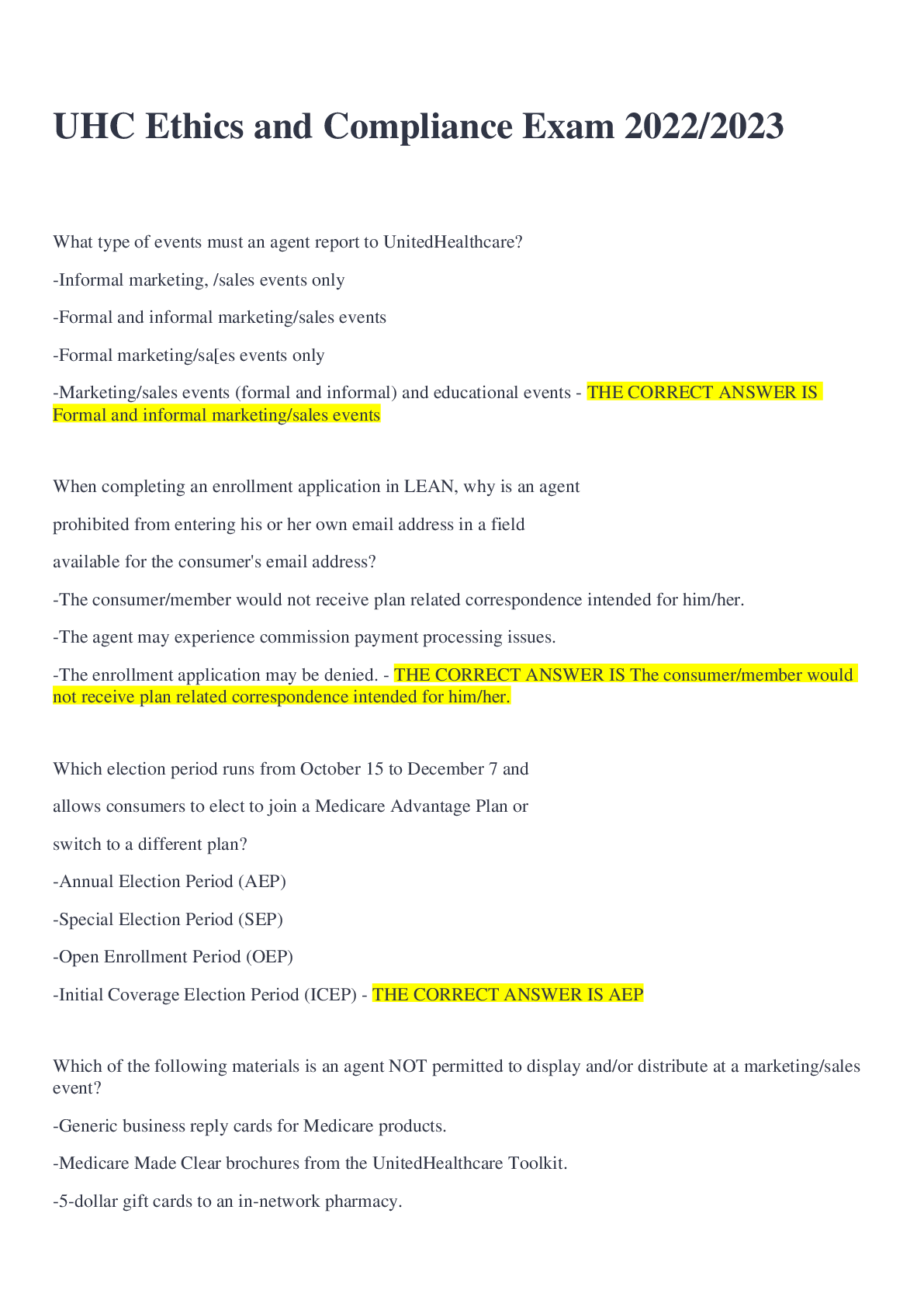




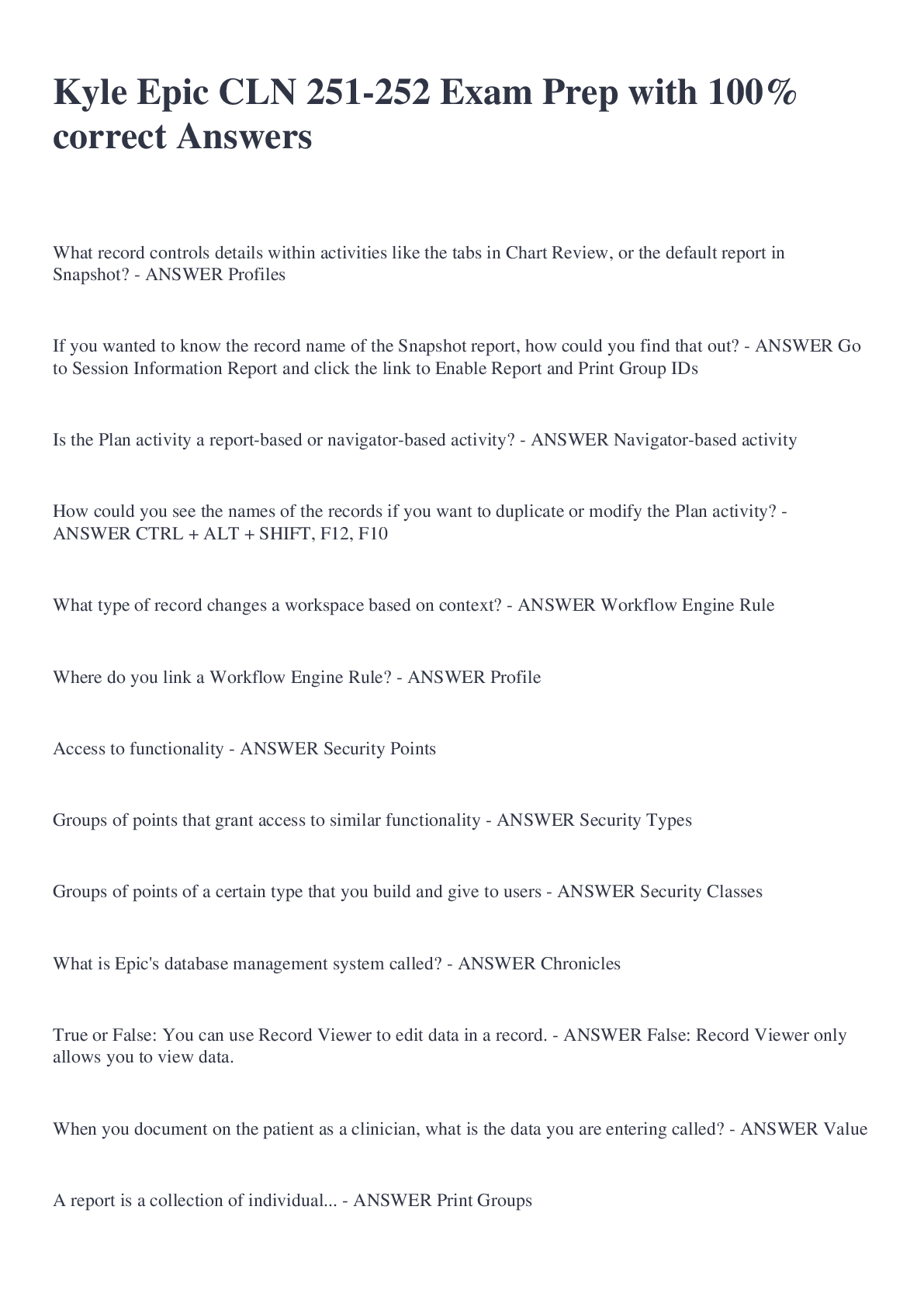


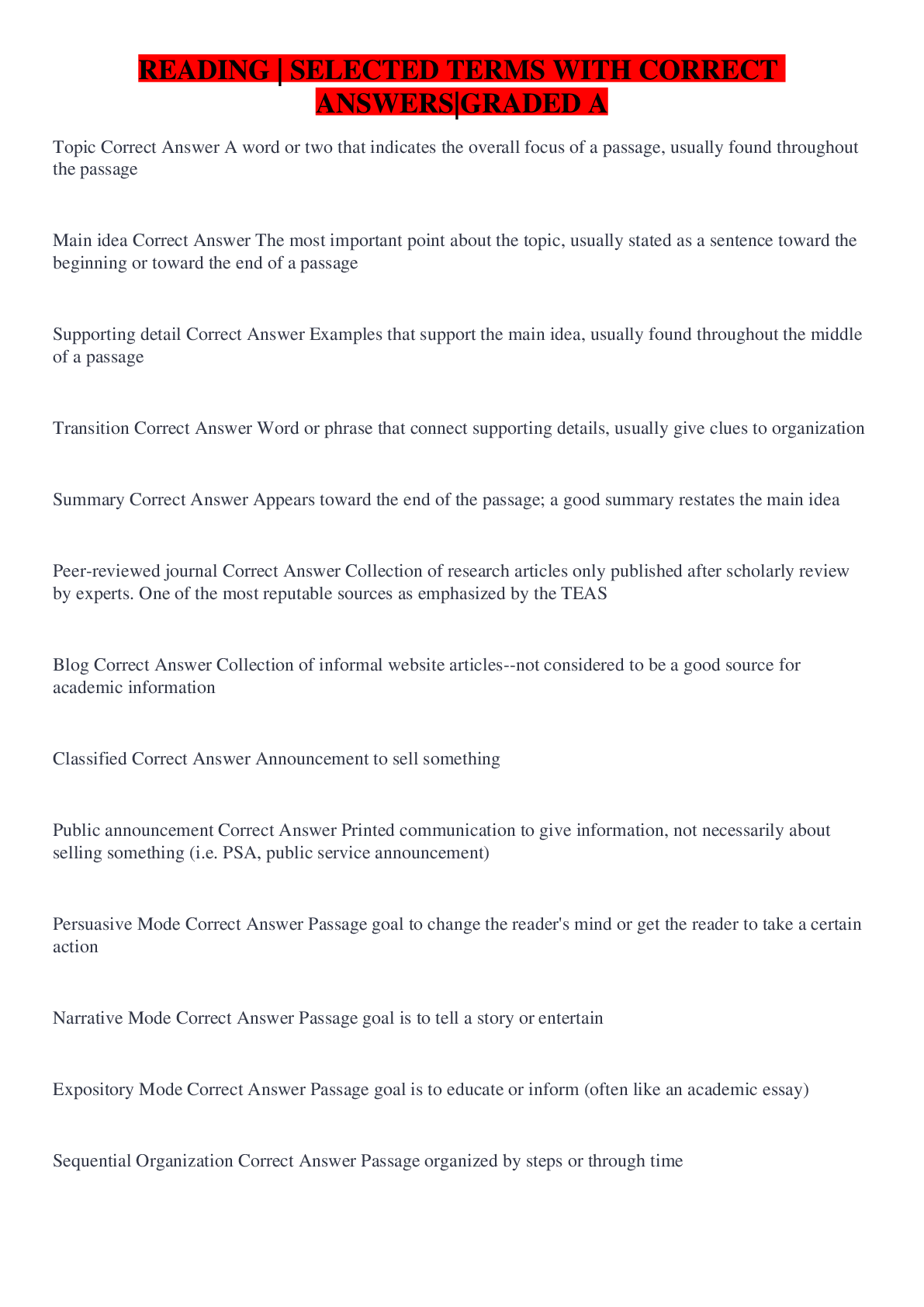
.png)
